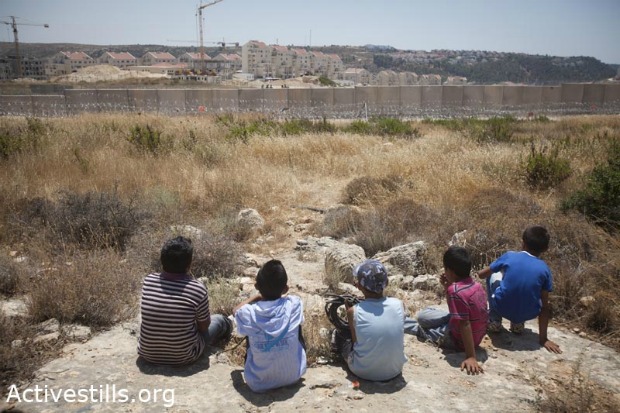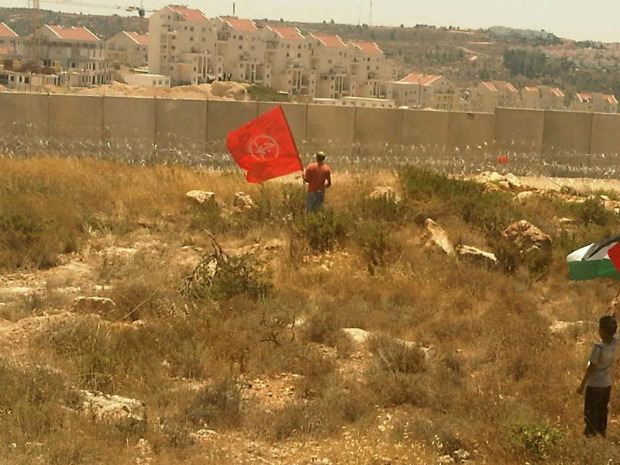By Libby Lenkinski
The experience on Friday, July 1st in Bil’in was surreal. The village, cut up by Israel’s separation barrier, has been the site of the joint Israeli-Palestinian struggle against the wall for five years now. On Friday, I walked down from the center of the village to the demonstration site – like I always do – and like people have been doing for nearly six years.
As I walked alongside the villagers, media, Israeli and international activists, Palestinian Authority officials – and I reached the top of the hill, I felt my heart start to pound. Because I’m not one of the brave bullet-dodgers nor a hardcore regular at every weekly demonstration, whenever I reach the top of the hill and look down at the path leading up to the fence, see the soldiers standing across the road on the other side, I always feel nervous. I always slow down at that point, and take my place as an observer at the back, my chest beating, and wait for the tear gas to start.
Today I reached the top of the hill, and pulse racing, I looked out over the path towards the fence, passed Bassem Abu Rahmah’s memorial, and saw no fence. I started walking down the path, slowly at first, and despite the ingrained sense that a canister or rubber bullet could appear from out of nowhere at any moment, I kept walking. I kept walking past Bassem’s memorial and walked up to the road, where the fence normally cuts us off – and then I crossed it.
Just like that.
I remember the evening in September 2007 when I sat with a room full of activists watching human rights lawyer Michael Sfard on prime time news describe the dramatic ruling of the Israeli Supreme Court that the wall in Bil’in must be moved. From 2007 until now, the army avoided implementing the Supreme Court’s ruling and for all these years, I always believed – indeed, I always had to believe – that there was actually a reason why the state wouldn’t move the barrier. But then Friday it just wasn’t there. The barrier vanished – poof – into thin air.
The disappearance made me think of a hilarious and disturbing story that I heard from a member of Breaking the Silence about his experience manning a checkpoint for several weeks, during which time he truly believed that this checkpoint was important. Then one day a bulldozer showed up and dismantled the checkpoint – suddenly cars were allowed through and nothing happened. The world did not stop.
The world did not stop when the Bil’in residents and their friends walked right up to where the fence used to be and crossed over that place into their land. I found myself completely overwhelmed, standing there on the other side of the former fence in Bil’in. This fence, which has symbolized so much – the occupation, the land-theft, the needless loss of life, the limitations of the Israeli High Court of Justice, the Palestinian popular struggle, the injustice that I spend my life fighting, and the power of solidarity and strategic resistance – this fence is gone.
I was certainly not alone on that road. Everyone – Palestinians, Israelis, activists, journalists, villagers – everyone seemed to be floating, wandering up and down the road, standing in the spot where soldiers have stood week after week, all of us expecting the world to stop. We were on the other side. Emotionally we were also on the other side – walking down to the land that had been so sorely missed, dancing, chanting, building what Mohammad Khatib calls “Bil’in West,” catching up. Not a single stone was thrown, there was no tear gas, no soldiers, just the sense that change happened – and while it is not perfect nor complete, the Separation Barrier in Bil’in was moved after six years of weekly demonstrations, a high court petition with three contempt of court suits for non-implementation, too many deaths and injuries, and intensive, exhausting work.
While I reel and process today – there are two distinct moments that are constantly in my mind.
When we arrived at the existing wall that remains (just over half a kilometer west of where the fence) used to be, while people danced and built, Ashraf Abu Rahmah, brother of the late Bassem Abu Rahmah and Jawaher Abu Rahmah took his flag and walked toward the new wall. He stood there for a few minutes alone in the quiet, looking at the wall and at the Israeli settlement Modi’in Illit behind it, and then raised his arms, still holding the flag. He had lost two siblings in the struggle against the fence, and now the fence was gone.
On the way back, I walked with Rani – whose father Waji is a central figure for many Israeli activists in Bil’in and one of the village’s most famous farmers. Rani is in a wheelchair but came the entire way up and down the hills on the dirt path because he wanted to be a part of the celebration. We chatted as we made our way back towards the village. At one point, we could see down into the valley west of the old fence where a road runs through – the road that was mostly used by the army until this week. Rani told me that in the few days since the fence was dismantled, people in the village who own cars have been driving out to this road – and riding on it all the way until the wall and back. Up and back.
Just because they can.
Libby Lenkinski is a Tel Aviv based human rights activist and works as the Director of International Relations at the Association for Civil rights in Israel (ACRI)


